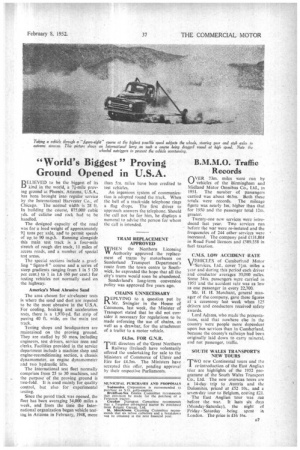"World's Biggest" Proving Ground Opened in U.S.A.
Page 41

If you've noticed an error in this article please click here to report it so we can fix it.
BELIEVED to be the biggest of its kind in the world, a 7f-mi1e proving ground at Phcenix, Arizona, U.S.A., has been brought into regular service by the International Harvester Co., of Chicago. The normal width is 28 ft. In building the course, 875,000 cubic yds. of caliche and rock had to be handled.
The designed capacity of the road was for a load weight of approximately 94 tons per, axle, and to permit speeds of up. to 90 m.p.h. Running alongside this main test track is a four-mile• stretch of rough dirt track, 11 miles of access roads, and a number of special test areas.
The special sections include a gruelling figure-8 " course and a series of steep gradients ranging from 1 in 5 (20 per cent.) to 1 in 1.6 (60 per cent.) for testing vehicles not normally used on the highway.
America's Most Abrasive Sand The area chosen for air-cleaner tests is where the sand and dust are reputed to be the most abrasive in the U.S.A. For cooling, braking and acceleration tests, there is a 1,970-yd. fiat strip of paving 40 ft. wide, on the main test track.
Testing shops and headquarters are maintained on the proving ground. They are staffed by 50 mem, including engineers, test drivers, service men and clerks. Facilities provided in the service department include -a machine shop and engine-reconditioning section, a chassis dynamometer, an engine dynamometer and two hydraulic lifts.
The International test fleet normally comprises from 25 to 30 machines, and the purpose of the proving ground is two-fold. It is used mainly for quality control, but also for experimental testing.
Since the paved track was opened, the fleet has been averaging 34,000 miles a week, and from the time the International organization began vehicle testing in Arizona in February, 1948, more than 5m. miles have been credited to test vehicles.
An ingenious system of communication is adopted round the track. When the bell of a track-side telephone rings a flag drops. The first driver to approach answers the telephone. Should the call not be for him, he displays a numeral to advise the person for whom the call is intended.
TRAM REPLACEMENT APPROVED
WHEN the Northern Licensing Authority approved the replacement of trams by motorbuses on Sunderland Transport Department's route from the town centre to Southwick, he expres8ed the hope that all the city's trams would soon be abandoned.
Sunderland's long-term conversion policy was approved five years ago.
CHAINS UNNECESSARY
REPLYING to a question put by Mr. Swingler in the House of Commons, last week, the Minister of Transport stated that he did not consider it necessary for regulations to be made enforcing the use of chains, as well as a drawbar, for the attachment of a trailer to a motor vehicle.
f4.5m. FOR G.N.R.
THE directors of the Great Northern Railway (Ireland) have voluntarily offered the undertaking for sale to the Ministers of Commerce of Ulster and Eire for £4.5m. The Ministers have accepted this offer, pending approval by their respective Parliaments. B.M.M.O. Traffic Records OVER 73m. miles were run by vehicles of the Birmingham and Midland Motor Omnibus Co., Ltd., in 1951. The number of passengers carried was about 463m. Both these totals were records. The mileage figure was nearly lm. higher than that for 1950 and the passenger total 12m. greater.
Twenty-one new services were introduced last year. Two services run before the war were re-instated and the frequencies of 244 other services were increased. The company paid £131,804 in Road Fund licences and £589.558 in fuel taxation.
C.M.S. LOW ACCIDENT RATE
VjEHICLES of Cumberland Motor V-Services, Ltd., cover 74m. miles a year and during this period each driver and conductor averages 30,000 'miles. Some 34m. passengers were carried in 1951 and the accident rate was as low as one passenger in every 22,700.
Mr. IL Merchant, general manager of the company, gave these figures at a ceremony last week when 125 drivers and conductors received safety awards.
Lord Adams, who made the presentations, said that nowhere else in the country were people more dependent upon bus services than in Cumberland, because the county's railways had been originally laid down to carry mineral, and not passenger, traffic.
SOUTH WALES TRANSPORTS NEW TOURS Tnew Continental tours and the new of the East Anglian tour are highlights of the 1952 programme of the South Wales Transport Co., Ltd. The new overseas tours arc a I4-day trip to Austria and the Dolomites, priced at £52 10s., and a seven-day tour to Belgium, costing £21.
The East Anglian tour was IMO before the war. It lasts six days (Monday-Saturday), the night of
Friday Saturday being spent in London. The price is £16 16s.




























































































